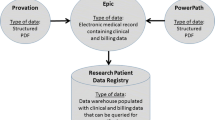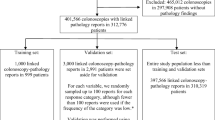Abstract
Background
Differentiating surveillance from non-surveillance colonoscopy for colorectal cancer in patients with inflammatory bowel disease (IBD) using electronic medical records (EMR) is important for practice improvement and research purposes, but diagnosis code algorithms are lacking. The automated retrieval console (ARC) is natural language processing (NLP)-based software that allows text-based document-level classification.
Aims
The purpose of this study was to test the feasibility and accuracy of ARC in identifying surveillance and non-surveillance colonoscopy in IBD using EMR.
Methods
We performed a split validation study of electronic reports of colonoscopy pathology for patients with IBD from the Michael E. DeBakey VA Medical Center. A gastroenterologist manually classified pathology reports as either derived from surveillance or non-surveillance colonoscopy. Pathology reports were randomly split into two sets: 70 % for algorithm derivation and 30 % for validation. An ARC generated classification model was applied to the validation set of pathology reports. The performance of the model was compared with manual classification for surveillance and non-surveillance colonoscopy.
Results
A total of 575 colonoscopy pathology reports were available on 195 IBD patients, of which 400 reports were designated as training and 175 as testing sets. Within the testing set, a total of 69 pathology reports were classified as surveillance by manual review, whereas the ARC model classified 66 reports as surveillance for a recall of 0.77, precision of 0.80, and specificity of 0.88.
Conclusions
ARC was able to identify surveillance colonoscopy for IBD without customized software programming. NLP-based document-level classification may be used to differentiate surveillance from non-surveillance colonoscopy in IBD.

Similar content being viewed by others

Abbreviations
- IBD:
-
Inflammatory bowel disease
- ARC:
-
Automated retrieval console
- NLP:
-
Natural language processing
- CRC:
-
Colorectal cancer
- VA:
-
Veterans affairs
- ICD-9:
-
International classification of diseases, 9th revision
- EMR:
-
Electronic medical records
- CPRS:
-
Computerized patient record system
- cTAKES:
-
Clinical text analysis and knowledge extraction system
- UIMA:
-
Unstructured information management architecture
- CRF:
-
Conditional random fields
- MALLET:
-
Machine learning for language toolkit
- PPV:
-
Positive predictive value
- CD:
-
Crohn’s disease
- UC:
-
Ulcerative colitis
- IC:
-
Indeterminate colitis
- CI:
-
Confidence interval
- NPV:
-
Negative predictive value
References
Kornbluth A, Sachar DB. Practice parameters committee of the American College of Gastroenterology. Ulcerative colitis practice guidelines in adults: American College of Gastroenterology, practice parameters committee. Am J Gastroenterol. 2010;105:501–523.
Farraye FA, Odze RD, Eaden J, et al. AGA technical review on the diagnosis and management of colorectal neoplasia in inflammatory bowel disease. Gastroenterology. 2010;138:746–774.
Velayos FS, Liu L, Lewis JD, et al. Prevalence of colorectal cancer surveillance for ulcerative colitis in an integrated health care delivery system. Gastroenterology. 2010;139:1511–1518.
Kottachchi D, Yung D, Marshall JK. Adherence to guidelines for surveillance colonoscopy in patients with ulcerative colitis at a Canadian quaternary care hospital. Can J Gastroenterol. 2009;23:613–617.
Savova GK, Masanz JJ, Ogren PV, et al. Mayo clinical text analysis and knowledge extraction system (cTAKES): architecture, component evaluation and applications. J Am Med Inform Assoc. 2010;17:507–513.
D’Avolio LW, Nguyen TM, Farwell WR, et al. Evaluation of a generalizable approach to clinical information retrieval using the automated retrieval console (ARC). J Am Med Inform Assoc. 2010;17:375–382.
Shiner B, D’Avolio LW, Nguyen TM, et al. Automated classification of psychotherapy note text: implications for quality assessment in PTSD care. J Eval Clin Pract. 2012;18:698–701.
Farwell WR, D’Avolio LW, Scranton RE, et al. Statins and prostate cancer diagnosis and grade in a veterans population. J Natl Cancer Inst. 2011;103:885–892.
McCallum AK. MALLET: A machine learning for language toolkit. http://mallet.cs.umass.edu; 2012.
Acknowledgments
The research reported here was supported by the American College of Gastroenterology Junior Faculty Development Award to J.K. Hou, a pilot grant from the Houston VA HSR&D Center of Excellence (HFP90-020) to J.K. Hou, the Department of Veterans Affairs, Veterans Health Administration, Health Services Research and Development Service, grant MRP05-305 to J.R. Kramer, and the National Institutes of Health/National Institute of Diabetes and Digestive and Kidney Disease Center grant P30 DK56338, K24 DK078154-05.
Conflict of interest
None.
Author information
Authors and Affiliations
Corresponding author
Rights and permissions
About this article
Cite this article
Hou, J.K., Chang, M., Nguyen, T. et al. Automated Identification of Surveillance Colonoscopy in Inflammatory Bowel Disease Using Natural Language Processing. Dig Dis Sci 58, 936–941 (2013). https://doi.org/10.1007/s10620-012-2433-8
Received:
Accepted:
Published:
Issue Date:
DOI: https://doi.org/10.1007/s10620-012-2433-8



